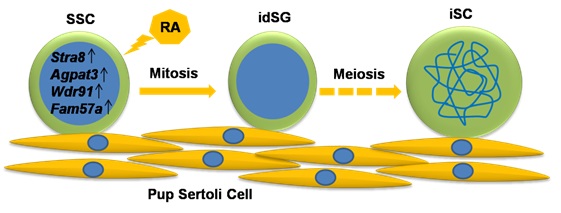The research team led by Dr. Chunsheng Han in the State Key Laboratory of Stem Cell and Reproductive Biology published a paper entitled “Retinoic Acid Is Sufficient for the in vitro Induction of Mouse Spermatocytes” in Stem Cell Reports on June 23, 2016. (http://www.cell.com/stem-cell-reports/abstract/S2213-6711(16)30068-6).
Meiosis is the key step for gametogenesis. However, the mechanism of mammalian meiosis remains poorly understood due to the lack of an in vitro model. Dr. Chunsheng Han and his team members report that retinoic acid (RA) is sufficient for inducing leptotene/zygotene spermatocytes from cultured mouse spermatogonial stem cells. Multiple genes regulated by RA were identified by RNA-sequencing. RA in combination with pup Sertoli cell co-culture resulted in a higher induction efficiency of 28%. Using this model, they have identified novel genes involved in meiosis initiation. This work has established a solid ground for the in vitro generation of sperm, which contributes to male infertility treatment.

Figure 1. Induction of spermatoctyes (iSC) from spermatogonial stem cells (SSC) via induced differentiating spermatogonia (idSG) using exogenous retinoic acid (RA) and Sertoli cell coculture from pup mice.
Dr. Han’s team has long focused on the establishment of an in vitro model of spermatogenesis. They have been able to culture mouse spermatogenic stem cells for long term and use these cells to generate genetically modified mice. They have also derived primordial germ cells from mouse iPS cells in vitro. These work have been published in journals such as Cell Research (2012)22:773;Stem Cell Research (2013)12:517;Stem Cells and Development (2015)24:471.

